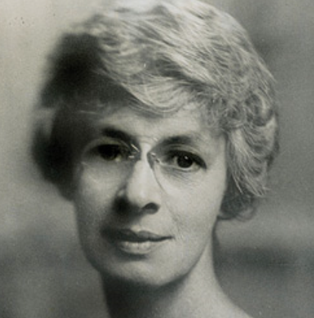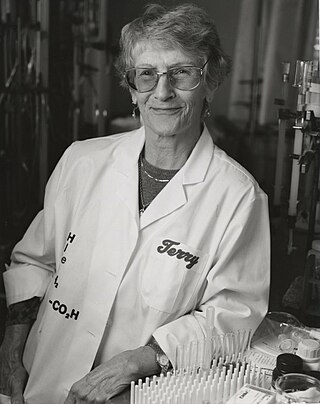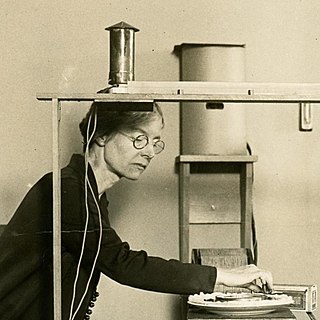Related Research Articles

Theda Skocpol is an American sociologist and political scientist, who is currently the Victor S. Thomas Professor of Government and Sociology at Harvard University. She is best known as an advocate of the historical-institutional and comparative approaches, as well as her "state autonomy theory". She has written widely for both popular and academic audiences. She has been President of the American Political Science Association and the Social Science History Association.

Graduate Women in Science (GWIS), formerly known as Sigma Delta Epsilon (ΣΔΕ), is an international professional organization for women in science. It was established as a scientific women's fraternity in 1921 at Cornell University, United States. It played an important role for women scientists for some fifty years when they were not allowed membership in most mainstream scientific organizations. GWIS is a non-profit 501(c)(3) organization with over 1,000 active members and more than 30 active chapters.
Mary Styles Harris is an American biologist and geneticist, president of Harris & Associates in Atlanta, Georgia, and owner of BioTechnical Communications, which produced the television documentary "To My Sister...A Gift for Life."

Judith Ethel Graham Pool was an American scientist. She is best known for the discovery of cryoprecipitation, a process for creating concentrated blood clotting factors which significantly improved the quality of life for hemophiliacs around the world.

Margaret Eliza Maltby was an American physicist notable for her measurement of high electrolytic resistances and the conductivity of very dilute solutions. Maltby was the first woman to earn a Bachelor of Science degree from the Massachusetts Institute of Technology, and the first woman to earn a Ph.D. in physics from any German university.
Rose Kohn Goldsen was a professor of sociology at Cornell University and a pioneer in studying the effects of television and popular culture.

Mary Swartz Rose was an American laboratory scientist and educator in the fields of nutrition and dietetics.
Margaret Bryan Davis was an American palynologist and paleoecologist, who used pollen data to study the vegetation history of the past 21,000 years. She showed conclusively that temperate- and boreal-forest species migrated at different rates and in different directions while forming a changing mosaic of communities. Early in her career, she challenged the standard methods and prevailing interpretations of the data and fostered rigorous analysis in palynology. As a leading figure in ecology and paleoecology, she served as president of the Ecological Society of America and the American Quaternary Association and as chair of the Department of Ecology, Evolution and Behavior at the University of Minnesota. In 1982 she was elected to the National Academy of Sciences and, in 1993, received the Eminent Ecologist Award from the Ecological Society of America.
Alice Hamlin Hinman was a psychologist who changed the public school education system from backwards to progressive from 1907 to 1919 through her influence and membership on the Lincoln Board of Education.
Sofia S. "Topsy" Simmonds was an American biochemist who studied amino acid metabolism and peptide metabolism in E. coli. Following training with Vincent du Vigneaud at Cornell University, she spent most of her career at Yale University. After decades as a researcher and then associate professor there, Simmonds became a full professor of biochemistry in 1975, and later served as Associate Dean of Yale College. With her husband Joseph Fruton, Simmonds coauthored the influential General Biochemistry, the first comprehensive biochemistry textbook. Simmonds received the American Chemical Society's Garvan Medal in 1969.
Anne M. Briscoe was an American biochemist and activist promoting women in science.

Thressa Campbell Stadtman was an American biochemist, notable for her discovery of selenocysteine, and her research on selenoproteins and bioenergetics. In addition she made significant advances in amino acid metabolism, enzymes dependent on vitamin B12, and the biochemistry of microbes.
Monica H. Green is an author and a historian who was a professor of history at Arizona State University. She is an expert in the history of women's health care in premodern Europe, medicine and gender, and she specialises in the history of infectious diseases in the pre-modern period.
Sally Gregory Kohlstedt is an American historian of science. She is a professor in the Department of Earth Sciences and in the Program in History of Science and Technology at the University of Minnesota. Kohlstedt served as the president of the History of Science Society from 1992 to 1993. Her research interests focus on the history of science in American culture and the demographics of scientific practice in institutions such as museums and educational institutions, including gender participation.
Edna Mosher was a Canadian entomologist and lepidopterist known for her pioneering work on Lepidoptera pupae morphology.

Louise Sherwood McDowell was an American physicist and educator. She spent most of her career as a professor of physics at Wellesley College and is best known for being one of the first female scientists to work at the United States Bureau of Standards, now the National Institute of Standards and Technology.
Frederic Lawrence Holmes was an American historian of science, specifically of chemistry, medicine and biology. He was Avalon Professor of the History of Medicine at Yale University and was known for his work developing Yale's programs in history of science and medicine. His scholarship included notable studies of Claude Bernard, Antoine Lavoisier, Justus Liebig, Hans Adolf Krebs, Matthew Meselson, Franklin Stahl, and Seymour Benzer. He was awarded a George Sarton Medal for lifetime achievement in the history of science and served as a president of the History of Science Society.
Janet Howell Clark was an American physiologist and biophysicist.
Sara Jane Rhoads was an American chemist. She was one of the first women in the United States to become a full professor of chemistry, helped to establish the chemistry department at the University of Wyoming, and was the recipient of the American Chemical Society's Garvan–Olin Medal in 1982.
Josephine Margaret Mitchell was a Canadian-American mathematician specializing in the mathematical analysis of functions of several complex variables. She was the victim of a notorious case of discrimination against women in academia when, after she married another more junior faculty member at the University of Illinois Urbana-Champaign, the university used its anti-nepotism rules to revoke her tenured position while allowing her husband to keep his untenured one.
References
- ↑ "Margaret Rossiter". Department of Science and Technology Studies, Cornell University. Retrieved 8 October 2024.
- 1 2 3 4 "Margaret W.Rossiter". Cornell University. Retrieved 25 February 2021.
- 1 2 3 4 5 6 7 8 "Writing Women into Science", Writing and revising the disciplines, Editor Jonathan Monroe, Cornell University Press, 2002, ISBN 978-0-8014-8751-4
- ↑ Nye, Mary Jo (2001). "News of the Society: Annual Meeting of the History of Science Society, Vancouver, 2-5 November 2000: Sarton Medal Citation". Isis. 92 (2): 349–350. JSTOR 3080633.
- ↑ James R. Shortridge (1978) Journal of Historical Geography 4(1)
- ↑ Mary Hargreaves (1977) New York History 01/1977
- ↑ Nathan Reingold (1976) History of Medicine and Allied Sciences doi : 10.1093/jhmas/XXXI.4.478
- ↑ John J. Beer (1976) Technology and Culture
- ↑ Stanley L. Becker (1976) BioScience 26(12) doi : 10.2307/1297511
- ↑ Morris Berman (1977) Isis 68(4)
- ↑ W. V. Ferrar (1976) The British Journal for the History of Science 9(1)
- ↑ Dominus, Susan (October 2019). "Women Scientists Were Written Out of History. It's Margaret Rossiter's Lifelong Mission to Fix That". Smithsonian Magazine. Vol. 50, no. 6. p. 44.
- 1 2 Pennisi, Elizabeth (October 15, 1990). "A Rough, Long Struggle in Science History". The Scientist.
- ↑ "Women scientists in America before 1920". WorldCat. OCLC 106181557.
- ↑ "Margaret W. Rossiter". John Simon Guggenheim Memorial Foundation. Archived from the original on 2013-10-12. Retrieved 2013-10-17.
- ↑ Rossiter, Margaret W. (1982). Women Scientists in America: Struggles and Strategies to 1940. JHU Press. ISBN 0-8018-2509-1.
- ↑ Murray, Margaret (March–April 1996). "Women Scientists in America: Before Affirmative Action, 1940-1972". Association of Women in Mathematics Newsletter. Archived from the original on 2017-02-12. Retrieved 2013-10-15.
- 1 2 3 "The Society: Margaret W. Rossiter History of Women in Science Prize". History of Science Society. Archived from the original on 2013-10-12. Retrieved 2013-10-17.
- ↑ "The Society: Pfizer Award". History of Science Society. Archived from the original on 2013-10-12. Retrieved 2013-10-17.
- ↑ Montgomery, Georgina M. (16 November 2012). "Women in Science: A Classic Continued Up to the Present". Science. 338 (6109): 884–885. doi:10.1126/science.1230772. S2CID 178713923.
- ↑ Carmen Magallón: Pioneras españolas en las ciencias, Madrid, CSIC, 2004: http://editorial.csic.es/publicaciones/libros/11110/978-84-00-07773-0/pioneras-espanolas-en-las-ciencias-las-mujeres-del.html
- ↑ Schiebinger, Londa (1999). "Has Feminism Changed Science". Signs. 25 (4). Harvard University Press: 33–34. doi:10.1086/495540. ISBN 0-674-38113-0. PMID 17089478. S2CID 225088475.